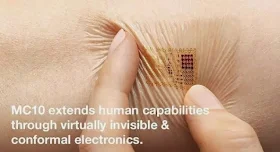The following from ExtremeTech.com
Motorola patents e-tattoo that can read your thoughts by listening to unvocalized words in your throat
by John Hewitt
 Imagine
trying to patent the smartphone, or for that matter, the tattoo. Any company
that could swing that, could probably also patent the fork and knife.
Incredibly, a new application from Google-owned Motorola Mobility seeks a
patent not for any particular utensil, but rather, for setting the table. In
other words, if you have an electronic smart tattoo, and want it to speak to
your mobile communications device, you may soon be able to do it in spades, but
you will have to do it Google style.
Imagine
trying to patent the smartphone, or for that matter, the tattoo. Any company
that could swing that, could probably also patent the fork and knife.
Incredibly, a new application from Google-owned Motorola Mobility seeks a
patent not for any particular utensil, but rather, for setting the table. In
other words, if you have an electronic smart tattoo, and want it to speak to
your mobile communications device, you may soon be able to do it in spades, but
you will have to do it Google style. Or
maybe not. It has been known for decades that when you speak to yourself in
your inner voice, your brain still sends neural spike volleys to your vocal
apparatus, in a similar fashion to when you actually speak aloud. The main
difference between the two, is that the nervous action driving covert speech as it is called, is subthreshold, and does not generate the
full muscle contraction. The same might also be said for imagining throwing a
baseball — it is probably not possible to even do so without simultaneously
calling up and at least partially launching unamplified motor programs. Stated
another way, your thoughts are your motor intentions, only they are not always
recognizable as such if they are sufficiently abstracted.
Or
maybe not. It has been known for decades that when you speak to yourself in
your inner voice, your brain still sends neural spike volleys to your vocal
apparatus, in a similar fashion to when you actually speak aloud. The main
difference between the two, is that the nervous action driving covert speech as it is called, is subthreshold, and does not generate the
full muscle contraction. The same might also be said for imagining throwing a
baseball — it is probably not possible to even do so without simultaneously
calling up and at least partially launching unamplified motor programs. Stated
another way, your thoughts are your motor intentions, only they are not always
recognizable as such if they are sufficiently abstracted. There is already a device known as a throat microphone
that has been used to record an auditory signal in noisy conditions like, for
example, the cockpit of a jet fighter. Developed along with the first pressure
suit back in 1934, it used a direct contact microphone to pick up sound waves
traveling through solid objects such as the throat wall. Later so-called throat
microphones, such as the Xbox 360 accessory, only use an open-air microphone.
They do not really exclude background noise, nor have the ability to pick up
unvoiced signals. What got some folks attention recently, namely those over at Patently
Apple, was a few peculiar statements in the patent regarding the recording
of galvanic skin responses. These guys first heard about the e-skin tattoo from
Regina Dugan, the former DARPA head who is now in charge of advanced research
at Motorola. Their article notes that the e-tattoo would provide a nice way to
do authentication, but the seemingly out of place inclusion of the lie
detection talk certainly raises some questions.
There is already a device known as a throat microphone
that has been used to record an auditory signal in noisy conditions like, for
example, the cockpit of a jet fighter. Developed along with the first pressure
suit back in 1934, it used a direct contact microphone to pick up sound waves
traveling through solid objects such as the throat wall. Later so-called throat
microphones, such as the Xbox 360 accessory, only use an open-air microphone.
They do not really exclude background noise, nor have the ability to pick up
unvoiced signals. What got some folks attention recently, namely those over at Patently
Apple, was a few peculiar statements in the patent regarding the recording
of galvanic skin responses. These guys first heard about the e-skin tattoo from
Regina Dugan, the former DARPA head who is now in charge of advanced research
at Motorola. Their article notes that the e-tattoo would provide a nice way to
do authentication, but the seemingly out of place inclusion of the lie
detection talk certainly raises some questions.Covert voice activation of your device in a crowd would definitely be a nice feature. Instead of actually speaking to Siri or Google Now, you could merely think your voice command. Detecting stress and other emotion could have some applicability too, although who else really needs to know if you have a lump in your throat? Perhaps I have not read that many patents recently, but there certainly did seem to be an excess of wording, and scope. Every wireless communications protocol I am familiar with was included in some form, somewhere. Not only were there definitions for words like “a” and “an,” but also actual percentages associated with a list of words like “about,” “approximately”, “essentially”, and “substantially”. Clearly this is one among several recent patents that we all may want to keep an eye on.

No comments:
Post a Comment